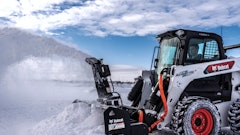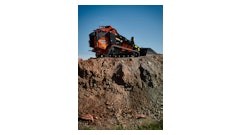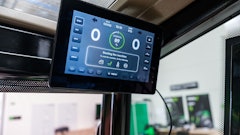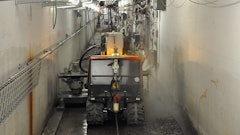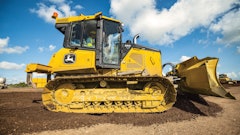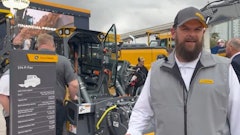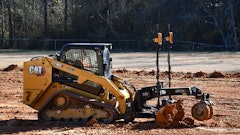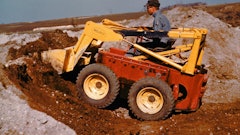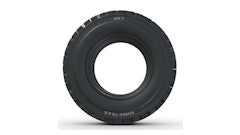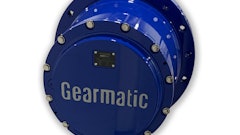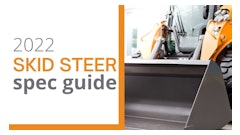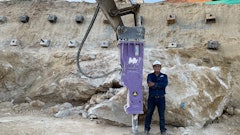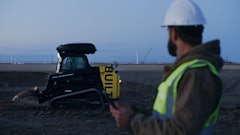
Like many industries, landscaping professionals have been hit hard by staffing shortages. According to a 2021 Green Industry Pros Benchmark Report, 71% of green industry businesses reported it difficult to find employees. When the adage, “many hands make light work,” can’t be a reality for your landscaping business, it’s important to have the right equipment on hand to make your team the most productive it can be.
One machine that is proving to be a productive, versatile and powerful solution on many jobsites is the stand-on skid steer. With its compact size and increased visibility, you can stay productive on a variety of tasks. Plus, stand-on skid steers can be outfitted with an assortment of attachments that can be switched out with ease. This is especially important as crews look to their equipment for an extra boost of productivity.
Here are three things to consider so you can get the most out of your stand-on skid steer, whether you have a lean crew or not.
1. Maintenance Checks
Downtime from equipment issues is one of the biggest hindrances to productivity for any crew. Having to bring your equipment in for servicing or waiting for parts can really slow down a team during the busy season. Daily maintenance checks help minimize the potential for major downtime due to equipment failure. Three simple daily checks include:
- Cooler: Check to see if there is debris blocking the cooler and that it is properly blown out. This can ensure your stand-on skid steer doesn’t overheat and keep you working efficiently.
- Track tension: A daily visual check of your track tension, one of the most common stand-on skid steer derailments, takes just seconds and could save you hours of downtime.
- Fluid levels: A quick check of your stand-on skid steer fluid levels, including oil, hydraulic and coolant before use, ensures everything runs smoothly.
2. Jobsite Considerations
An important element of productivity is making sure you have the best equipment onsite for the job. When choosing a stand-on skid steer, consider the job and space you will have to work. Small stand-on skid steers are great for residential projects, as they are compact enough to maneuver through gates and minimize yard damage. Small stand-on skid steers also afford crews space on their trailer to haul away logs and brush.
However, large stand-on skid steers have more horsepower and weight, allowing teams to lift larger trees and move heavier loads across the jobsite. This can increase productivity exponentially. With more carrying capacity, crews do not have to spend time making many cuts to logs. They can work faster and often complete three or four jobs in one day.
Both large and small stand-on skid steers have their place in the tree care and landscaping industries. Having any size stand-on skid steer on your site will bring increased maneuverability and visibility. Landscaping and tree care professionals who want to round out their scope of work and increase their productivity should consider having both sizes in their fleet.
 A standard bucket or fork attachment is one of the most popular attachments for stand-on skid steers and is a low-cost alternative for moving material on and off the jobsite.Ditch Witch
A standard bucket or fork attachment is one of the most popular attachments for stand-on skid steers and is a low-cost alternative for moving material on and off the jobsite.Ditch Witch
3. Tree Care Attachments
In addition to the size of your stand-on skid steer, consider which attachments would best optimize your jobsite. For example, rather than hauling multiple machines to a jobsite, you can simply bring one stand-on skid steer outfitted with a range of attachments to suit the needs of various projects. Having the right stand-on skid steer attachments increases your crew’s productivity and versatility. Below are four attachments to help you get the most out of your stand-on skid steer and allow your crew to boost productivity:
- Tree/Brush Grapple: The grapple bucket is an ideal attachment for smaller crews, especially when it is attached to a large stand-on skid steer. With a grapple attachment, you are able to carry larger loads across a jobsite quickly and safely. Without a tree or brush grapple, the crew would need to spend extra time cutting the branch into smaller pieces that could be carried by hand or pieces that would fit into a standard bucket. This attachment is ideal to promote jobsite efficiency.
- Stump Grinder: The stump grinder is the attachment that pays dividends in crew versatility. In the past, arborists and landscapers would have to bring a stand-on skid steer and a stump grinding machine when removing stumps. The stump grinder attachment eliminates the need for another machine. This minimizes the number of machines that are hauled to a jobsite and the cost to maintain multiple machines.
- Bucket/Fork: A standard bucket or fork attachment is one of the most popular attachments for stand-on skid steers and is a low-cost alternative for moving material on and off the jobsite. This attachment helps you lift large piles of brush, soil, debris or other materials that need to be relocated. There are a variety of bucket types to choose from, depending on the application.
- Auger: Ideal for landscaping and tree care, an auger attachment on a stand-on skid steer will help you quickly open holes in the ground for tree or post installations. An auger attachment is a great solution to speed up your work and allow you to take on more jobs in a day, especially if you usually rely on a hand-held auger machine.
Finding ways to make the most with what you have is the key to finding success with a lean crew.
Landscaping companies, like D2Scapes from Hot Springs, Ark., have learned the value of getting creative and relying more on their machines than ever. Owner Darrel Anderson credits much of his team's productivity to the support of his stand-on skid steers.
“Before I had the stand-on skid steers, I wouldn’t have had the equipment or manpower to take on both jobs at the same time,” Anderson said. “And because of that I likely would have lost one of the jobs because the customer didn’t want to wait. With these, I knew I could make both work at the same time, even with a smaller crew.”
Anderson is confident that he will continue to succeed in the landscaping industry with the help of his stand-on skid steers and attachments.
D2Scapes is just one of many landscaping and tree care operations that has leaned more heavily on their equipment amid the workforce shortage. The increased versatility and productivity stand-on skid steers and their attachments provide help relieve pressure on even the most efficient crew. Choosing the right equipment and following regular maintenance requirements and machine best practices are key to driving jobsite efficiency and improving the bottom line.








